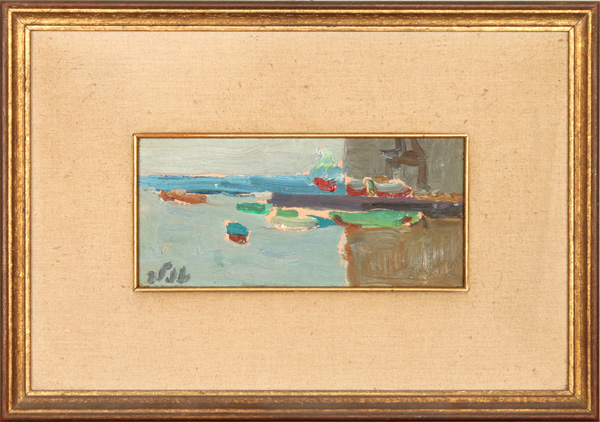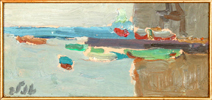< Back to Paintings
< Previous Next >
Samuel (Shmuel) Tepler - Oil on Canvas - Harbor View
שמואל טפלר - שמן על בד - נוף נמל
Samuel Tepler (1918-1998) immigrated to Israel on 1949, when, at the age of 31, he was already, so to speak, a migration veteran. He was born in Poland where he also started painting. Then, when the Nazis invaded Poland he escaped to the USSR which gave him refuge until the end of World War II. Then he returned to Poland and a little bit later, moved to Italy where he studied painting with some of the leading Italian artists of the time in the Brera Academy of Fine Arts in Milan. When he came to Israel he settled in Tel-Aviv and found a living from painting and from teaching painting. One of his favorite places was Jaffa's harbor, and he used to take his paints and canvas there and paint what he saw. The subject of the picture in front of us is one of these harbor views.
The Hebrew poet Nathan Zach writes in one of his well-known poems, called "By the seashore" in a very free translation to English: "The ships that brought us to build Pitom and Ramses traced their way back and we were left on the shore... and on the pier people indulged in love, and pigeons looked for seeds, and dogs ran hither and thither...".
I find that these lines, although torn from the poem and taken out of their full context, still carry the essence of this poem which has the same sentiment that underlies Tepler's painting. It captures the point of view of the Jewish emigrant, arriving to Israel from Europe, tired of wanderings, which sees in Israel the last and definite stop on his voyage.
In 1949, most of the people came to Israel by the water way, and hence the big wide sea symbolizes for the wanderer the world that closes behind him when he lands at the shore. But, the sharp line dividing the land from the sea is the center of the drama, both in Zach's poem and in Tepler's painting. This vertical line is not drawn as a line but rather formed in paint, as a contrast between the relatively light colors of the sea and the sky, and the dark tones of the pier. The wanderer is surprised to discover that he is tied up and bound (psychologically, emotionally, and ideologically) to the shoreline and the pier. He is destined to a hesitant mode of living between the old and the new world.
The sea and the sky express his longings to the old world, his dreams of a return voyage which will never take place since "The ships that brought us... traced their way back", since we have chosen not to go back, since we took upon ourselves the labor of giants (to build the ideological Pitom and Ramses as our fathers have built the real Pitom and Ramses), since we escaped the places we had come from. But our existence in the new land is sharply defined: we live on the edge. We do not dare to move rightward across the frame of the picture into the promised but hostile land. The shore and the harbor are our last point of contact with our past, and we stick to them in a desperate search for a sense of continuity in our life, like a person that still keeps an insurance policy although it has expired long ago.

Samuel Tepler signature in Hebrew
Biography of Samuel (Shmuel) Tepler - ביוגרפיה של הצייר שמואל טפלר
שמואל טפלר היה צייר בצבע שעמד בצל בבחינת "אין נביא בעירו". צריך לקרוא רק מקצת ממה שכתבו מבקרי הציור האירופאים על טפלר ועל תערוכותיו ולהבין בצער שאמן דגול זה לא הוערך כראוי על ידי הממסד האמנותי הישראלי - לא על ידי הציירים ולא על ידי הקהל.
טפלר, "היהודי הנודד", הגיע לחוף המבטחים התל-אביבי בתחילת שנות החמישים והתפרנס מציור ומהוראת הציור. בשנות השישים רכשו טפלר והאמן משה רוזנטליס מבנה ישן מתקופת הטורקים בלב שכונת עג'מי ביפו וחלקו בו כסטודיו - הם היו האמנים היהודים הראשונים שקבעו שם את משכנם וטפלר, שנצמד אל הים, היה יוצא יום יום אל הנמל לצייר שם את שראו עיניו. התמונה שלפנינו היא אחד מפירותיה של התבוננות זו.
בשירו "לחוף ימים", כותב נתן זך: "האוניות שבהן הביאו אותנו לבנות את פיתום ואת רעמסס הפליגו כלעומת שבאו ואנו נותרנו על החוף... וברציף אהבו אנשים ויונים ליקטו זרעונים וכלבים פסעו אנה ואנה...". טפלר צייר את קו החוף - התפר שבין העולם שממנו בא, לארץ שאליה הגיע. החוף, רציף הנמל והסירות הן נקודות המגע האחרונות בין הים והשמיים האווריריים שמשמאל, לארץ המובטחת הקשה שמימין. "כי האוניות שבהן הביאו אותנו... שבו כלעומת שבאו" אומר זך.
מראה הנמל הוא נקודת ההתחלה
לביטוי אבסטרקטי של רגשותיו ותחושותיו - טפלר מתבונן בנוף בעיניים של משורר ומתרגם
אותו לעולם הצבעוני המיוחד שאפיין את עבודתו בשנות השישים. פלטת הצבעים שלו "מוסטת
לכחול" ברוח ציירי
הקיאריסמו
Chiarismo האיטלקים של שנות השלושים,
הצבעים עצמם צנועים, מאופקים לעומת משיכות המכחול הנועזות
שנותנות את
ההרגשה של משטח רחב עד אינסוף.
Size of painting (without frame): 8.5" x
4.1" - 21.7 cm x 10.5 cm - 8.5 in x 4.1 in
Type of frame: Wood & cloth
Painting technique: Oil on Canvas
Origin: Israel
Date: 1968
Signature: "טפלר" - signed in Hebrew by the artist on the on left-bottom
of the painting
Price: Call
References:
Monografia Di Samuel Tepler by Mario Lepore
Samuel Tepler - Oil on Canvas - Interior: Still Life on a Blue Table
Biography of Samuel Tepler
- Shmuel Tepler - A distinctive Jewish Painter
© Dan Levy - Art Pane Home of Original Paintings and Sculptures
< Back to Paintings
< Previous Next >


